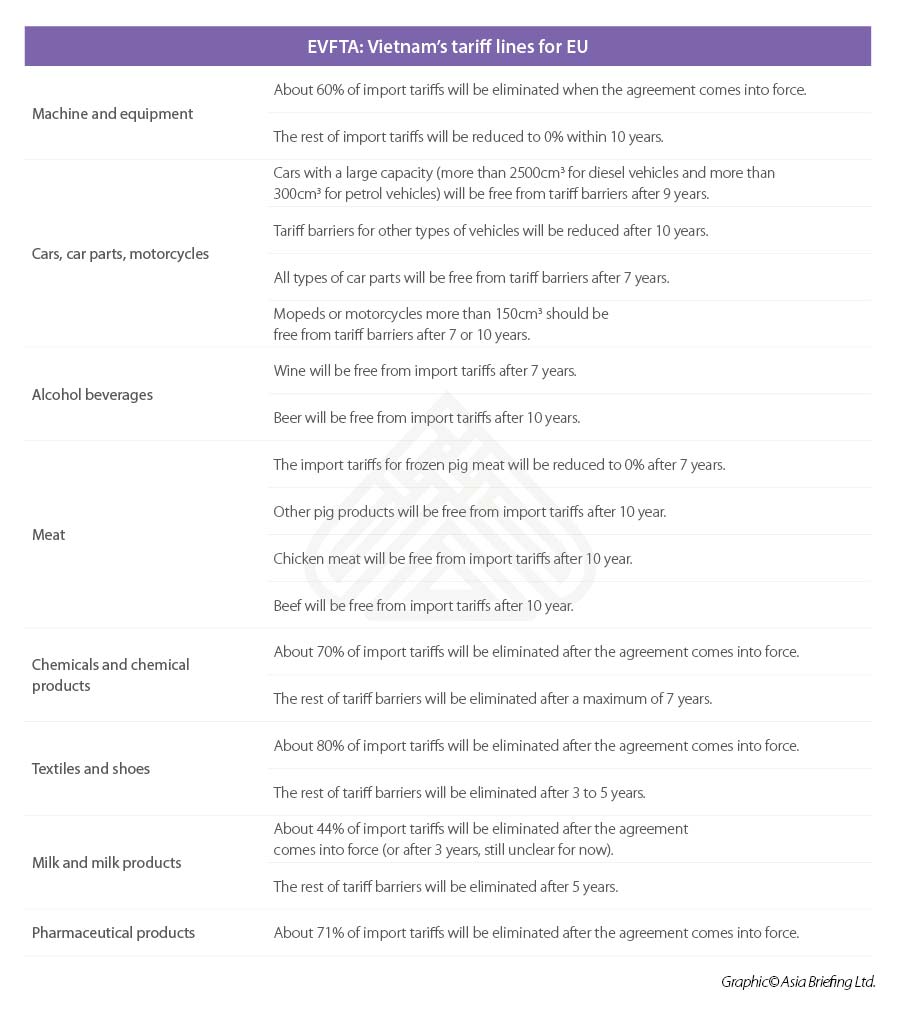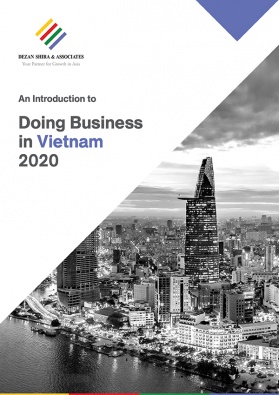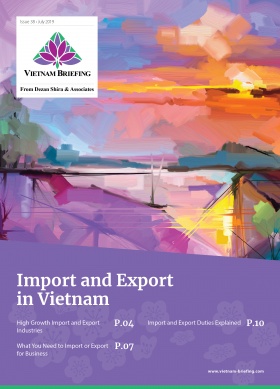EVFTA: How Will European and Vietnamese Investors Benefit?
The ratification of the EVFTA
On February 12, 2020, the European Parliament ratified the EU-Vietnam Free Trade Agreement (EVFTA) receiving 401 votes in favor, 192 against and 40 abstentions. On the same day, the EU-Vietnam Investment Protection Agreement (“EVIPA”) was also approved marking a historic step in EU-Vietnam trade relations. Both agreements were already officially signed in Hanoi In June 2019.
Industry and Trade Minister Tran Tuan Anh described the free trade agreement between the EU and Vietnam as a lever for growth, bringing the possibility of becoming more involved in a market with a gross domestic product (GDP) of US$18 trillion.
Key aspects of the EVFTA are the dismantling of customs barriers and the facilitation of European-Vietnamese trade relations. For example, after the official entry into force of the free trade agreement, approximately 65 percent of EU exports to Vietnam and around 70 percent of EU imports from Vietnam will be exempted from customs duty immediately. The remaining customs obligations are to be abolished in perspective over a path of 10 years (99 percent duty exemption) and 15 years (99.8 percent duty exemption), with the exception of crude oil and coal.
When the EVFTA will officially come into force – is currently still unclear. If the EVFTA is presented to the Vietnamese National Assembly in May, the EVFTA could enter into force as early as July this year (and immediately eliminate 65 percent and 70 percent of the tariff lines respectively).
A preliminary overview of the product categories affected by the EVFTA can be found below.
Vietnam’s strong economic growth
The ratification of the EVFTA comes at a time when the Vietnamese economy is developing significantly; with GDP growth rates of > 7 percent in 2018 and 2019, Vietnam is one of the strongest growth countries in Southeast Asia. In a report published in 2017, the auditing firm PwC even came to the conclusion that Vietnam is the de facto fastest growing (and most promising) economy in the world. This is particularly impressive against the background of an ongoing trade dispute between the US and China, which has affected the global supply chain and forced many nations to adjust their economic outlook.
Since 1995, Vietnam has experienced average GDP growth of 6.7 percent, with its GDP rising from US$20.7 billion in 1995 to around US$261 billion in 2019. The socio-economic impact of such growth is enormous; the Vietnamese population has been able to double its standard of living repeatedly within a 10.5-year cycle. The poverty rate – which was at a worrying 49 percent in 1992 – was last estimated at only 3 percent. On the other hand, around 45 million people were liberated from poverty.
In the Global Competitiveness Index 2019 report by the World Bank, Vietnam ranks 67th out of 141 countries, a significant improvement compared with the previous year (77th place). In the Doing Business 2020 report, Vietnam ranks 70th, showing a largely stable business environment compared to previous years. With these achievements, Vietnam has succeeded in continuously attracting foreign direct investment, with an increasing number of greenfield projects and the total FDI stocks now amounting to US$145 billion.
The EVFTA should further boost developments and indicators described above.
Trade between Vietnam and the EU
But what does the ratification (and soon, coming into force) of the EVFTA mean for the EU in concrete terms?
With a foreign trade volume of about US$41.3 billion, the EU is currently among Vietnam’s largest trading partners: according to the European Commission, Vietnam is the EU’s 16th-largest trade partner and within the Association of Southeast Asian Nations (ASEAN), the EU’s second-largest trading partner. Combined, ASEAN is the EU’s third-largest trading partner outside Europe (after the US and China).
The EU’s main exports to Vietnam are high tech products, including electrical machinery and equipment, aircraft, vehicles, and pharmaceutical products, while Vietnam’s main exports to the EU are telephone sets, electronic products, footwear, textiles and clothing, coffee, rice, seafood, and furniture.
EVFTA: Practical implications and advantages
In principle, the EVFTA implies increased competitiveness between EU and Vietnamese marketplaces. Foreign products, which may now enjoy a tariff advantage because of the abolition of import duties, should present serious competition for domestic products.
VinFast – a unit of Vietnam’s largest conglomerate Vingroup – is the country’s first fully-fledged domestic car manufacturer. Within the next five years, VinFast aims to produce about 250,000 cars annually, which is 92 percent of all cars sold in Vietnam last year. Exemption from customs barriers should benefit this plan, and also create new competition in the EU car market.
Those EU companies that regularly trade with Vietnam can find out whether and when their products can benefit from the customs exemption by checking the relevant customs tariff numbers (HS Codes) in the related documents of the European Trade Commission. The European Trade Commission distinguishes between A-products (immediate duty exemption) and B-products (from B3 to B15; duty exemption within three to 15 years).
In a report, research and advisory platform Germany Trade & Invest (GTAI) points out that the EVFTA provides better access to public procurements in Vietnam. EU companies can take part in public projects and PPP projects more easily after the agreement officially comes into force, leaving their footprint in Vietnam.
Thanks to the current ratified investment agreement EVIPA, in which the EU and Vietnam have both decided to facilitate the investment environment for companies from both sides (including strengthening the legal framework, especially intellectual property), it should be easier for EU companies to invest in the previously highly restricted sector. For example, the maximum foreign shareholding in commercial banks has been increased from 30 percent to 49 percent.
In addition, EU companies can benefit from the non-economic provisions of the EVFTA; the agreement is also intended to enforce much-criticized environmental and human rights standards in Vietnam and, for instance, to ban forced labor. Furthermore, workers in Vietnam should be allowed to form a trade union unrelated to the Communist trade union federation. The free trade agreement aims to promote Western (democratic) values in Vietnam and thus make the country more attractive for EU investors.
Outlook
The developments in Vietnam described above emphasize the country’s potential and its increasing importance within Southeast Asia, which are not diminished because of the growing pressure of its “big brother” China (including the ongoing trade dispute with the US, rising wage costs, political unrest in Hong Kong and the outbreak of the coronavirus “COVID-19”).
The EVFTA, with its liberalization of customs duties and the deepening of trade and business relations, represents a great opportunity for EU companies. It will provide greater access to an emerging market with almost 100 million people, including about 55 million workers. In addition, the agreement opens opportunities for partnership, dialogue and cooperation and creates stronger relations with the Southeast Asian region.
Thus, the EVFTA seems to be more than just a trade agreement. It is also a response to the “battle of systems” which is currently on-going in international trade disputes between the US and China. Instead of protectionist representations of power as well as the silent toleration of large state-owned enterprises, the EU continues to rely on the recipe of “change through trade” – enriched with social and ecological requirements to promote long-term and value-adding partnerships.
About Us
Vietnam Briefing is produced by Dezan Shira & Associates. The firm assists foreign investors throughout Asia from offices across the world, including in Hanoi, Ho Chi Minh City, and Da Nang. Readers may write to vietnam@dezshira.com for more support on doing business in Vietnam.
We also maintain offices or have alliance partners assisting foreign investors in Indonesia, India, Singapore, The Philippines, Malaysia, Thailand, Italy, Germany, and the United States, in addition to practices in Bangladesh and Russia.
- Previous Article Vietnam: Rückblick auf das Jahr 2019 und Ausblick auf 2020
- Next Article Die Sicherheit ausländischer Touristen in Vietnam – ein Reiseziel unter Kontrolle (trotz COVID-19)









